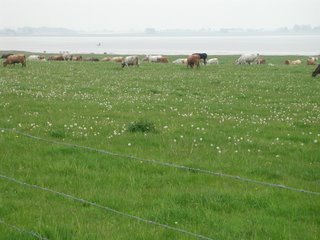
I’m deep into Michael Pollan’s The Omnivore’s Dilemma: A Natural History of Four Meals.
What surprises me is the book’s density. In his talks, Pollan says he follows the food chain of three meals: a fast food hamburger from McDonald’s, a supper cooked with ingredients from Whole Foods and a meal made from food he hunted and foraged himself.
I’m on page 77 – admittedly not very far in a 411 page book – but I haven’t seen a hint of McDonald’s yet. In fact, Pollan front loads his book with a lot of science about corn. He includes details about its history, its chemical and molecular structure, and the pros and cons of hybridization. This part is very well-written, but it’s not an easy read. I had expected to begin with an artfully written first person narrative that talked about fast food, and used that as a jumping off point for other issues.
The more difficult beginning suggests that Pollan’s readers are, for the most part, a devoted and very intelligent bunch of people who are willing to think hard. This is unusual in today’s world where everything is dumbed down to the lowest common denominator. This book demands that the reader concentrate closely. I read a lot of nonfiction, but not a lot of science nonfiction, so perhaps this is normal.
In his lecture, Pollan talked about the increasing corporatization of organics. Just because milk is organic, he offered as an example, doesn’t mean that the cows are leading a leisurely pastoral life. In fact, most cows that produce organic milk are as tightly squeezed into barns as other cows – they just get organic corn. Pollan pointed out that a consumer could tell which cows ate grass by reading the print on the side of the cartoon. If the writing doesn’t mention grass, the cows are not loose on a pasture.
I’ve been feeding my children organic milk for most of their lives. I made the switch after hearing how growth hormones fed to cows were migrating to their milk. Some scientists thought the hormones might explain why American girls are entering puberty earlier than ever before.
After I made the switch to organic, I didn’t pay close attention to which kind of milk I bought. I mostly purchased Horizon because it was the most available.
After Pollan’s talk, I looked at the milk in my refrigerator more closely. I had a carton of a new brand of milk, called O organics. It’s Safeway’s new line of organics, and it’s noticeably cheaper than other brands. But here is what the description on the carton says:
“Our dairy pastures are environmentally friendly, maintained with the use of recognized organic horticultural practices. The dairy cows that produce O organics Milk enjoy a healthy mix of fresh air, plenty of exercise, clean drinking water and a wholesome 100% certified organic diet.”
Notice there is no mention of grass.
On the carton of milk produced by Clover Organic Farms, in contrast, are these words:
“The family farms on the North Coast have open, green pasture, plenty of walking area, fresh air, clean bedding, and are all American Humane Association Free Farm certified.” It goes on to say that “These family farms provide their cows with a diet of 100% organically grown feed.”
This suggests the cows do get to graze.
So, as Pollan suggests, buying local food does ensure better quality.
No comments:
Post a Comment